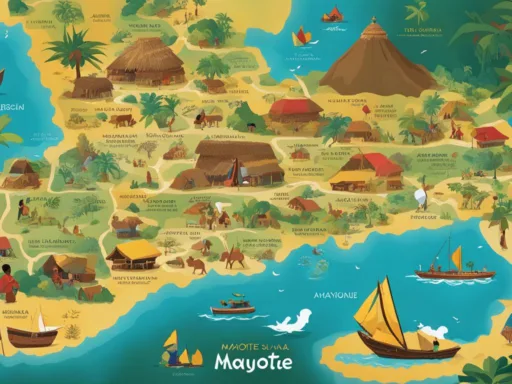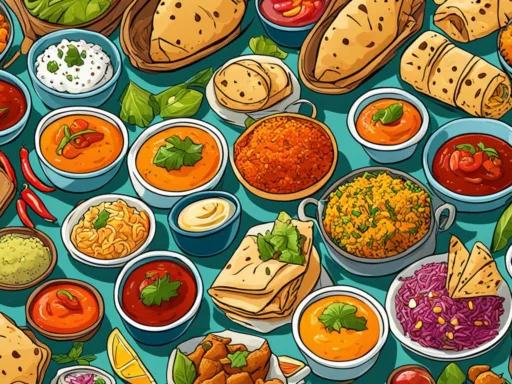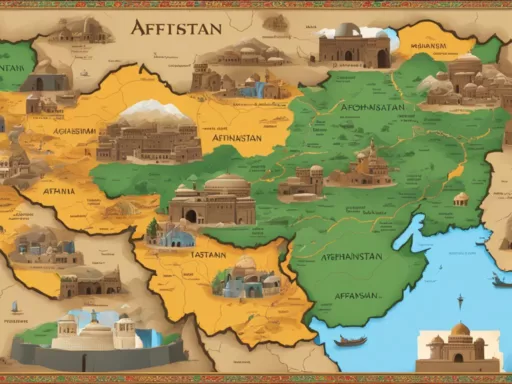Within the dual-island nation of Trinidad and Tobago, a babel of voices contributes to a linguistic landscape that is as vibrant as the country’s famed Carnival. Surprisingly, while English reigns as the official language, the islands are home to a linguistic richness that mirrors their diverse history and ethnic composition. In this social mosaic, languages spoken in Trinidad and Tobago range from Trinidadian English Creole and Tobagonian Creole to Trinidadian Hindustani, revealing layers of cultural interplay. The islands’ narrative is indeed told through the tongues of its people, making the linguistic landscape of Trinidad and Tobago an intriguing study of cross-cultural fertilization.
Key Takeaways:
- Trinidad and Tobago’s linguistic diversity is a reflection of the nation’s complex history and cultural amalgamation.
- Despite English being the official language, a myriad of dialects and vernacular tongues paint a vivid linguistic portrait.
- Creole languages, imbued with influences from various ancestries, are central to everyday communication.
- Trinidadian Hindustani plays a critical role in maintaining the Indo-Trinidadian cultural identity.
- The linguistic repertoire of the islands extends beyond communication, influencing music, folklore, and social customs.
- Understanding the languages spoken in Trinidad and Tobago offers insight into the broader Caribbean linguistic heritage.
The Official Language of Trinidad and Tobago: English
Within the dual-island nation of Trinidad and Tobago, the historically rooted presence of English stands as the undisputed official language. Trinidad and Tobago Standard English, an heirloom from British colonial times, continues to shape the nation in boundless ways, ranging from educational systems to the intricacies of governmental operations. It is this language that unifies the islands’ diverse populace and enables their active participation in a global context.
British Colonial Legacy and Education
Education in Trinidad and Tobago is anchored by the English language, with Trinidad and Tobago Standard English serving as the principal medium through which knowledge is imparted. From the early stages of schooling through to tertiary education, English forms the scaffold for learning, literacy, and dialogue. This educational framework stands testament to the British colonial legacy that has propelled the nation into modernity, whilst equipping its citizens with the linguistic tools necessary for both local and international engagement.
Usage in Government and Media
The corridors of power and public communication in Trinidad and Tobago resonate with the clear tones of English. In realms of governance, legal proceedings, parliamentary debate, and the drafting of official documents, the language’s role is clear and omnipresent. This influence transcends the functional and formal; it spills over into the domain of media. English guides the public narrative, delivering news, fuelling discourse, and importing global culture, all while being steeped in the local context of Trinidad and Tobago’s societal fabric.
Trinidad and Tobago’s Creole Heritage
The linguistic tapestry of Trinidad and Tobago is richly interwoven with the threads of Creole languages—unique blends that signify the islands’ multicultural legacy. At the heart of this heritage lies the impact of various linguistic contributions that have created distinct Creole dialects, used extensively in local communities and everyday life.
Trinidadian English Creole: A Mix of Influences
Trinidadian English Creole stands as a testament to the island’s history, a vibrant mix drawn from a diverse set of linguistic traditions. Borrowing aspects from English, African dialects, Spanish, and even French Creole, this language serves as a primary means of communication across Trinidad, seamlessly moving between social settings and reflecting a spirit of adaptability and fusion.
Tobagonian Creole: Distinctly Different
Tobagonian Creole, while sharing roots with the Trinidadian variant, distinguishes itself through unique characteristics that are more closely aligned with Lesser Antillean Creoles. In Tobago’s day-to-day discourse, this Creole language resonates, evidencing clear distinctive features, especially in its foundational, basilectal forms, nurturing a sense of regional identity distinct from the Trinidadian experience.
Trinidadian Hindustani: Preserving Indian Heritage
In the vibrant tapestry of Trinidad and Tobago’s cultural heritage, Trinidadian Hindustani stands out as a testament to the rich Indo-Trinidadian culture that has thrived on the islands since the arrival of South Asian indentured laborers. The dedication to language preservation in Trinidad and Tobago is a reflection of the community’s commitment to its history and identity. Amid the contemporary chorus of modern Caribbean life, this language echoes the narratives of the past while inspiring future generations.
The Role in Indo-Trinidadian Culture
Trinidadian Hindustani acts as a cultural cornerstone for the Indo-Trinidadian community, enveloping a treasure of historical narratives, family traditions, and artistic expressions. It serves as the backbone for cultural practices, and traditional festivals and is deeply interwoven within the genres of local music that have garnered both national and international acclaim.
Efforts to Revive and Promote the Language
The government and cultural organizations have laid down several initiatives to revitalize the use and understanding of Trinidadian Hindustani. These efforts range from educational programs in schools to the incorporation of the language in cultural events and media. Promoting the use of Trinidadian Hindustani ensures that the Indo-Trinidadian heritage remains an integral part of the nation’s identity.
| Initiative | Purpose | Impact |
|---|---|---|
| Language Classes | To educate the youth and interested individuals in the foundational elements of Trinidadian Hindustani | Facilitating language transmission to younger generations |
| Cultural Performances | To showcase the language’s beauty through art forms such as music and dance | Highlighting the language’s role in contemporary arts and fostering public interest |
| Media Integration | To broadcast programs and segments in Trinidadian Hindustani on radio and television | Increasing language visibility and everyday usage |
| Community Workshops | To engage the community in active language use and preservation practices | Empowering communities to be custodians of their linguistic heritage |
The Linguistic Landscape of Trinidad and Tobago
The rich tapestry of languages in Trinidad and Tobago is a vibrant reflection of its diverse populace, a true testament to the island nation’s complex historical narrative. The linguistic diversity serves as a cultural cornerstone, underscoring the intricate blend of ethnic groups that call Trinidad and Tobago home.

Language Diversity and Ethnic Makeup
The ethnic mosaic of Trinidad and Tobago is painted with strokes from Indian, African, European, mixed, Dougla, Chinese, Indigenous, and Arab communities. The interactions among these different ethnic groups in Trinidad and Tobago have given rise to a unique linguistic environment where diversity is not merely present, but embraced and celebrated.
Impacts on Local Dialects and Vernacular
The convergence of languages and cultures within Trinidad and Tobago has yielded an array of local dialects, each with its own distinct voice. These dialects are living embodiments of the islands’ ethnic diversity, encapsulating the heritage and identities of different communities. The interplay of various languages has enriched the Trinidad and Tobago language diversity, fostering a dynamic lingua franca that is both expressive and emblematic of the country’s pluralistic society.
| Ethnic Group | Linguistic Influence | Examples of Vernacular Expressions |
|---|---|---|
| Indian | Trinidadian Hindustani | “Beta” (child), “Roti” (flatbread) |
| African | Trinidadian English Creole | “Liming” (socializing), “Wine” (dance move) |
| European | English, Spanish, French | “Bonjour” (hello in French), “Adiós” (goodbye in Spanish) |
| Mixed/Dougla | Hybrid Creole | “Douglarize” (to mix), “Calaloo” (a dish) |
| Chinese | Chinese Pidgin English | “Fenkee” (predicate in Pidgin), “Chow Mein” (noodles) |
| Indigenous | Cariban, Arawakan loans | “Caiman” (a type of lizard), “Aripo” (a location) |
| Arab | Arabic loans | “Kofta” (meatball dish), “Baksheesh” (tip/gratuity) |
As the table illustrates, the language diversity is not just an academic concept but a lived reality, shaping the way people interact, share, and create experiences. Through language, the stories of Trinidad and Tobago continue to unfold, narrating a tale as diverse and dynamic as its people.
Indigenous Tongues: Relics of a Pre-Columbian Past
The echoes of indigenous languages of Trinidad and Tobago are a testament to a rich cultural history that predates modern civilization. Although their usage has dwindled, languages such as the Cariban language—once spoken by the Kalina people—and the Arawakan language, specifically Shebaya, are more than mere relics; they are central to understanding the pre-Columbian ethos that shaped the archipelago’s identity. Despite their declining presence, communities and scholars alike hold these languages in high regard, acknowledging their importance as cultural artifacts.
- Cariban language: Vital for understanding the Kalina heritage
- Arawakan language: Offering insights into the linguistic fabric of the Shebaya people
The complexities of these tongues, from their unique phonetics to their linguistic structures, continue to be subjects of academic intrigue and cultural significance. While languages like Yao, Carib, and Kari’nja have either faced extinction or are endangered, efforts to preserve these languages remind us of the invaluable legacy of the native peoples of Trinidad and Tobago.
As symbols of resilience and the persistence of the human spirit, indigenous languages serve as reminders that the Caribbean’s cultural wealth is rooted in an impressively diverse linguistic landscape. Despite the impact of European colonization and subsequent societal changes, the remnants of these ancient tongues are intrinsic to the Caribbean’s living memory—holding stories, wisdom, and systems of knowledge that are yet to be fully discovered and appreciated.
Indigenous languages of Trinidad and Tobago may be whispering from the outskirts of the cultural mainstream, but they possess an enduring resonance. They narrate a past that continues to influence the present and deserve concerted efforts to ensure that they do not fade into silence, affirming that the Cariban language and Arawakan language are more than echoes; they are lines in the continuous chapter of the islands’ evolving narrative.
languages spoken Trinidad and Tobago: A Pluralistic Society
The linguistic tapestry of Trinidad and Tobago is a testament to the island’s historical embrace of diversity. Within this Caribbean nation, the harmonious coexistence of multiple dialects and languages is not only the norm but also a celebration of its pluralistic fabric. The implementation of Trinidad and Tobago dialects in daily conversation highlights the rich cultural legacy and the adaptive essence of its people. The linguistic diversity of Trinidad and Tobago presents an engaging spectrum of vernaculars that are imbued with the nation’s collective history and individual stories.

Walking the streets of Port of Spain or Scarborough, one is likely to hear a symphony of accents, each telling its tale of ancestry and influence. This day-to-day linguistic agility underscores a society that comfortably navigates between the formal English of commerce and education and the intimate cadence of its creoles and local dialects. The ability of the people to switch between registers—compartmentalizing yet weaving together the formal and informal—reflects a social intelligence grounded in deep-rooted linguistic diversity.
| Dialect | Description | Typical Usage |
|---|---|---|
| Trinidadian English Creole | Rich melange of English infused with African and other language influences. | Casual conversation, folklore, music. |
| Tobagonian Creole | Diverges from Trinidadian Creole, echoing Lesser Antillean Creole roots. | Everyday communication in Tobago. |
| Trinidadian Hindustani | Carries the legacy of Indo-Trinidadian ancestors, fostering cultural connection. | Ceremonies, cultural events, some media. |
| Standard Trinidad and Tobago English | An offshoot of British English, serving formal and official purposes. | Government, education, formal media. |
It’s this fluid movement between Trinidad and Tobago dialects and the foundation of Trinidad and Tobago Standard English that energizes the islands’ linguistic diversity. Generations interlace their discourse with both a local flair and an understanding of the global language landscape. Each interaction, be it in the marketplaces or business sectors, demonstrates an evolving linguistic identity of Trinidad and Tobago—ever dynamic, yet remaining intrinsically connected to its historical roots.
Language Policies and Education in Trinidad and Tobago
The educational framework of Trinidad and Tobago is a testament to the country’s commitment to fostering a literate and well-informed society. At the heart of this framework is the fundamental role of English in Trinidad and Tobago education. Anchoring the curriculum, English serves as the primary medium for imparting knowledge across diverse academic disciplines. Yet, within this English-centric system lies an emerging respect for linguistic diversity, signaling a shift towards inclusive education that honors the nation’s cultural legacy.
Language Instruction in Schools
Within the classroom setting, the importance of English is undisputed, ensuring students develop strong communication skills to thrive in a globalized world. However, the educational institutions of Trinidad and Tobago are beginning to integrate additional language options, responding to a society that is proudly heterogeneous. Language instruction now gradually extends to the treasures of indigenous and heritage languages, empowering students to connect with their ancestral roots while bolstering their cognitive and social abilities in a bilingual world.
Bilingual Education and Language Preservation Programs
Looking beyond conventional instruction, bilingual education in Trinidad and Tobago is gaining momentum. Innovative programs are taking shape, aiming to preserve the linguistic identity of the islands by incorporating languages like Trinidadian Hindustani and the spectrum of Creole dialects into the educational syllabus. These efforts not only enrich the students’ academic experience but also serve as cultural preservation, ensuring that the voices of the past remain audible and influential in shaping the nation’s future.
As Trinidad and Tobago continues to navigate the complexities of its linguistically variegated landscape, the adaptive educational policies symbolize a bridge between the ubiquity of international lingua franca and the localized, intimate dialects of the islands. These stewardship initiatives within the realm of education are pivotal for the sustained vibrancy and authenticity of Trinidad and Tobago’s linguistic heritage.
Communication and Commerce: Languages in the Economy
The fusion of language and economy is a pivotal facet of Trinidad and Tobago’s societal framework. The nation’s economic engagements, both domestically and on an international stage, are significantly influenced by its linguistic proficiencies. As the official language, English positions Trinidad and Tobago on the global map, simplifying international communication channels that are crucial for trade, diplomacy, and cross-border partnerships.

In the realm of tourism, the ability to converse with travelers in multiple languages not only elevates the visitor experience but also amplifies Trinidad and Tobago’s allure as a culturally rich destination. The presence of linguistic diversity within the archipelago’s borders opens doors for explorers to immerse themselves in an authentic cultural exchange. Language, thus, becomes an invaluable asset that enriches the islands’ economic tapestry and underlines their international relations.
The Role of Language in Tourism
Languages in Trinidad and Tobago play a cardinal role in the thriving tourism industry. Cultural tourism, in particular, benefits from the harmonious coexistence of various languages spoken throughout the islands. From guided heritage tours conducted in English to local festivals wherein Creole dialects are heard, the range of linguistic experiences adds depth to the nation’s touristic appeal.
Business and International Relations
Trinidad and Tobago’s engagement in international affairs and commerce is bolstered by its linguistic capabilities. Fluency in English ensures seamless transactions and negotiations with global entities, cementing the nation’s position as an agile player in international relations. Local businesses also capitalize on this linguistic advantage to forge alliances and navigate the intricacies of the global marketplace.
Social and Cultural Expressions Through Language
The vibrant cultural fabric of Trinidad and Tobago is interwoven with a multiplicity of languages that have given birth to a captivating array of social and cultural expressions. Through the dynamic interplay of Trinidad and Tobago music, folklore, and literature, the nation’s complex identity and heritage are melodiously sung, ardently told, and intricately written into the heart of its society.
Music and Folklore
Trinidad and Tobago’s music is a pulsating celebration of life, with genres like calypso and soca narrating the islands’ stories, thrilling crowds, and uniting people in a rhythmic declaration of their multicultural legacy. Folklore remains a bastion of Trinidad and Tobago’s oral heritage, with tales imbued with the wit and wisdom of ancestors told to the cadence of language throughout the generations.
Chutney music, in particular, encapsulates the fusion of Trinidad and Tobago folklore with Trinidadian Hindustani, creating a soundtrack that moves both the young and old, immigrant and native alike.
Literature and Media
The written word in Trinidad and Tobago spans the spectrum of voices and experiences characteristic of the islands. Literature has long been a conduit for the nation’s diverse voices, emotionally chronicling the myriad facets of Trinidad and Tobago’s social fabric. Media, contemporaneously, functions as an arena where the vibrancy of Trinidad and Tobago literature is shared and celebrated, contributing to a thriving discourse that reverberates within and beyond the islands’ shores.
| Author | Genre | Notable Works |
|---|---|---|
| V.S. Naipaul | Fiction and Non-fiction | A House for Mr Biswas, In A Free State |
| Earl Lovelace | Fiction | The Dragon Can’t Dance, Salt |
| Sam Selvon | Fiction | The Lonely Londoners, Moses Ascending |
Conclusion
The tapestry of languages that characterizes Trinidad and Tobago is not only a testament to the country’s historical journey but is also a key factor in its cultural and social identity. Looking forward, the future of Trinidad and Tobago languages rests on a delicate balance between globalization’s homogenizing effects and the local efforts toward language preservation opportunities in Trinidad and Tobago. While English may serve as the commercial and educational linchpin, the heart of the nation beats with the rhythms of its diverse linguistic heritage, from Creole patois to the melodies of Bhojpuri.
The Future of Linguistic Diversity in Trinidad and Tobago
As we venture into the future, the cultural tapestry woven by Trinidad and Tobago’s diverse languages faces the dual challenges of modernization and assimilation. Remaining mindful of the intrinsic value these languages hold is crucial for maintaining the vibrant cultural plurality that defines the islands. The commitment to this endeavor will not only enrich local identity but will also reinforce the nation’s international cultural capital.
Challenges and Opportunities for Language Preservation
The protection and enhancement of Trinidad and Tobago’s linguistic diversity will inevitably confront challenges. However, these trials are met with robust opportunities for growth and sustainability. By fostering community-driven language initiatives, advocating for educational reform that includes bilingual and Creole language education, and garnering policy support, Trinidad and Tobago can ensure that its wide array of languages vibrantly endures. It is with these proactive efforts that the islands’ distinctive voice will continue to resonate authentically both at home and on the global stage.






